The mystery began on January 17 when Vashon Nature Center received an email about a large skeleton found on the beach at Maury Island Marine Park. The beachcombers reported it was picked clean and looked to be made of cartilage, not bone. It was several feet long and curved, and in their photo, it looks like the remains of a mythological sea serpent. There are very few creatures living in Puget Sound that are this big with skeletons of cartilage.
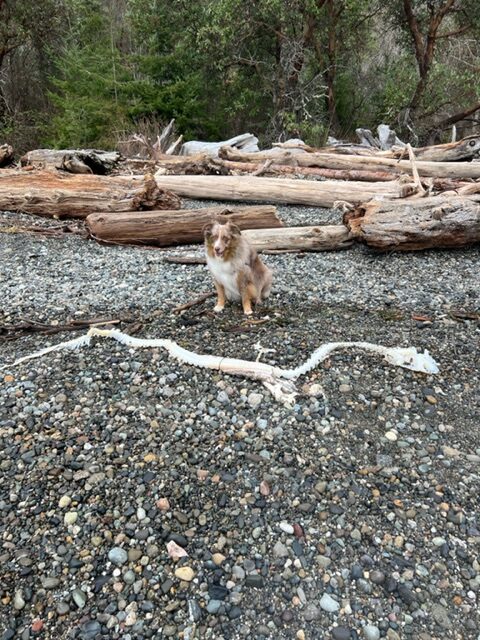
A quick email to VNC Science Advisors John Rupp (retired shark researcher) and Gary Shugart (Slater Natural History Museum) confirmed my initial hunch — these were the remains of a bluntnose sixgill shark (Hexanchus griseus). This was an exciting and rare find because these animals spend most of their time deep in Puget Sound.
Fast forward to March 14, and we heard from another islander about a heavily scavenged shark found on the beach near Maury Natural Area. Unfortunately, it was washed away by the tide and could not be relocated.
A week later, on March 22, during a beach walk near Sandy Shores, Tonya Trapp found and reported a completely intact sixgill shark. All of these sightings were happening inside Maury Island State Aquatic Reserve, so I contacted the Washington Department of Natural Resources Aquatic Reserves team. They promptly put me in touch with Lisa Hillier at Washington Department of Fish and Wildlife who was interested in doing a necropsy on the shark. I contacted VNC volunteer Bob Lane who lived nearby. He dragged the shark into a rowboat to keep it from washing away so that Washington Department of Fish and Wildlife (WDFW) scientists could pick it up the following day.
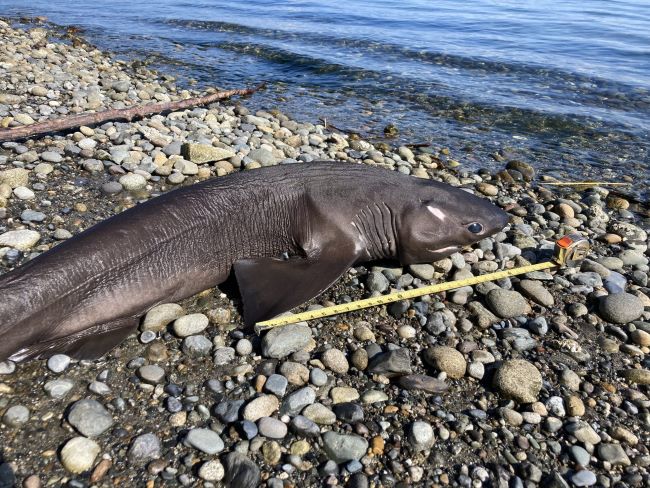
And then on March 29, during a Vashon Nature Center staff meeting, we had an urgent call from Samantha Schoner, a teacher from Truman High School in Federal Way. She and her students had found a “huge shark” at Point Robinson. We canceled the meeting and headed over, increasingly curious and worried about these mounting shark deaths.
Who are the sixgills?
Sixgill sharks are a bit of a mystery. They are deep-water animals, making them very hard to study. We have very little information on population numbers of these sharks because of this. They live in all oceans of the world and regularly occupy areas of the ocean 6000−8000 feet deep — a niche that they have maintained with little competition since the early Jurassic (before dinosaurs walked the earth!). Here in Puget Sound, during the day they troll the sea bottom for flatfish, other sharks, hake, dead carcasses, seals, and more. At night, they come up to the shallows to feed or give birth. These gentle giants (they are slow swimmers and do not attack people) are both apex predators and useful scavengers helping to recycle dead marine matter back into the ecosystem. Because of their ecological importance this species has been listed as a species of greatest conservation need in Washington’s State Wildlife Action Plan. Sixgills are also listed as a Near Threatened species in the IUCN’s global rankings.
In the early 1990s, researchers began to study these sharks in Puget Sound. VNC Science Advisor John Rupp was part of this initial Shark Task Force which included researchers from Pt. Defiance Zoo and Aquarium, Washington Department of Fish and Wildlife, National Marine Fisheries Service, and Seattle Aquarium. These scientists tagged sharks to follow their movements. This work revealed new information about how sixgill sharks may use Puget Sound.
Sixgills are the largest sharks in Puget Sound; females are larger than males and can grow up to 16-feet long. They have strikingly green eyes and six rather than five gills. Females swim into Puget Sound from the ocean to give birth in shallow bays. They can have as many as 100 live pups at one time! These pups are on their own from day one — the young live in Puget Sound until they are about 10 years old. When they reach maturity, they journey out the Straight of Juan de Fuca to live a slow-moving, prehistoric life in the depths of the Pacific Ocean. Females return to the Sound to give birth. Puget Sound could be described as a sixgill nursery!
While many people are shocked to learn that Puget Sound hosts sharks (we have 11 species!), local fishers are not. We even found this historic photo of a basking shark (Cetorhinus maximus), extremely rare visitors to Puget Sound, while going through old archives for the Natural Wonder natural history exhibit. For many years shark fishing was a sport that resulted in the brutal deaths of six-gill sharks likely many of them mature females returning to pup. In 2000 Washington Department of Fish and Wildlife shut down sport fishing for sixgill sharks after realizing that the practice was more widespread than previously believed. Today, sixgill shark fishing is illegal in Puget Sound.
The deep Manzanita Trench off Manzanita Point on Maury Island is a high activity spot for sixgills. The depth of the trench juxtaposed with the shallows of the harbor makes a good pupping ground. And, pups tend to have high site fidelity as they grow. Which brings us back to this March.
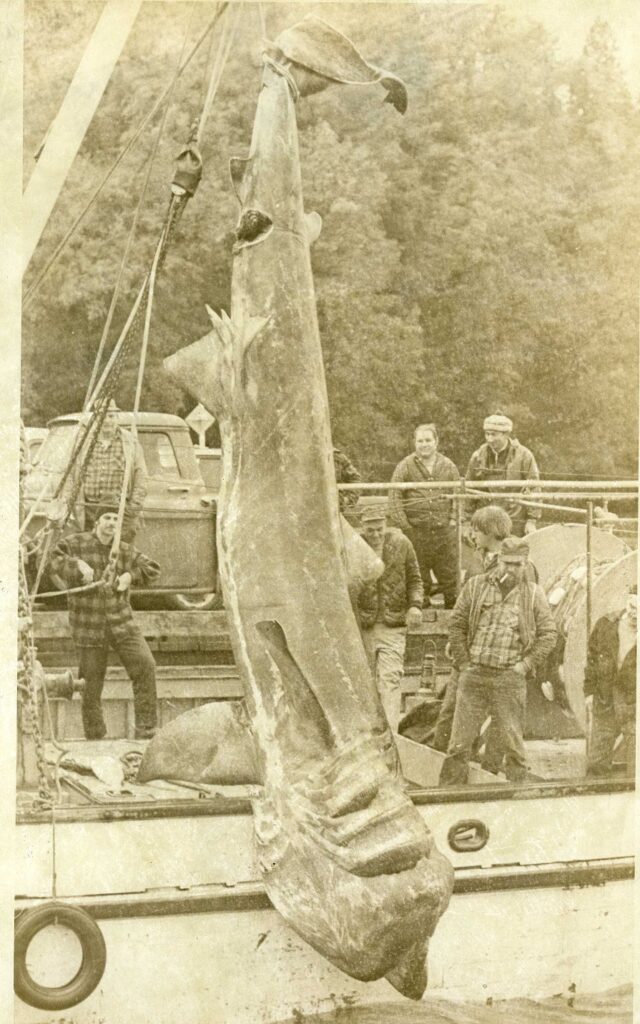
Moving the shark
Lisa Hillier at WDFW was planning a necropsy on the Sandy Shores shark when we called with the news of yet another specimen. They didn’t have the crew to pick it up, so we started up our trusty Science Adventure Lab (a VW bus past her prime but up to the task) to meet Bob Lane, and VNC Science Advisors John Rupp and Jeff Adams at Pt. Robinson.
We found the shark right away. Her beautiful dark grey skin sparkled in the sun and looked and felt like sandpaper. As we arrived, a young boy was kneeling beside her quietly stroking her head.
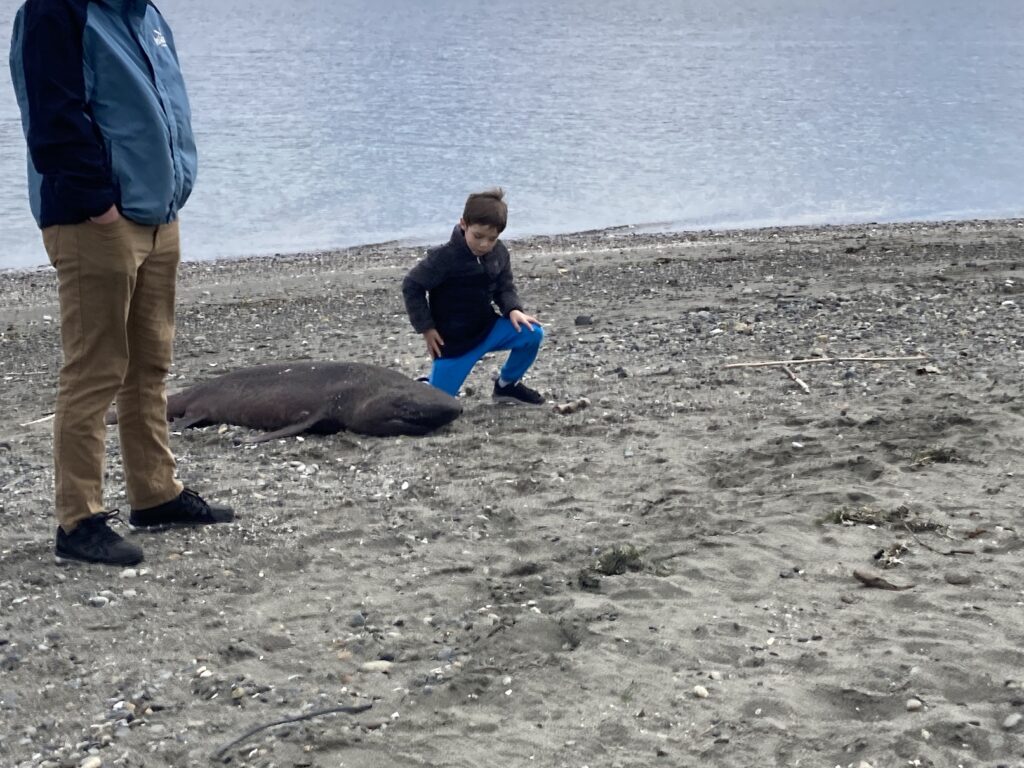
Upon examination, Rupp immediately found a hook in the corner of the shark’s jaw. He explained that this was not the size of hook used for shark fishing (which is illegal for sixgills in Puget Sound), but one used for bottom trawling for fish like rockfish or salmon.
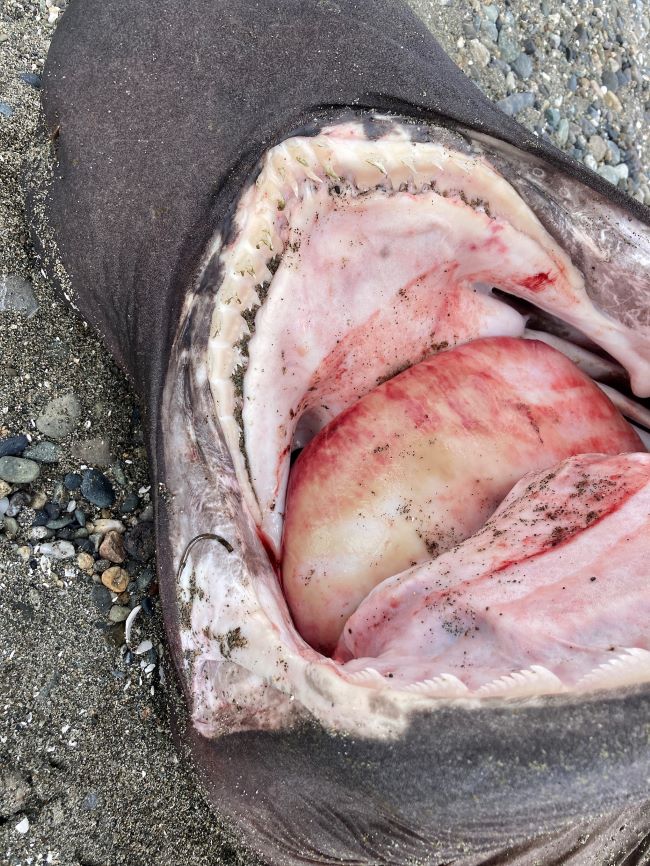
This indicated that the shark’s death was possibly a case of incidental catch, but even with the hook in her mouth, we weren’t certain that this was the cause of death. A necropsy would help answer more questions.
We wrapped her carefully in tarps, recruited some nearby bystanders to help us lift her, and moved her to the van.
Finding some answers
According to National Oceanic and Atmospheric Administration Scientist Dayv Lowry, the two most common reasons sixgills wash up on beaches are from ingesting derelict fishing gear or complications during birthing. The researchers checked all the shark’s organs, including the stomach. Everything looked normal except the gall bladder, which was enlarged indicating that the shark had been stressed. Was this related to the hook we found? A more detailed search of the mouth and head revealed a gaff wound. A gaff is a large hook attached to a wooden pole. As fishers reel in a catch, it can be used to hoist fish out of the water. The examination also revealed that the hook in the shark’s mouth had been cut.
“There was a good deal of interest in this necropsy,” said Tyler Goodspeed, a Washington Conservation Corps member who works for the Aquatic Reserves program and attended the necropsy, “it is mind blowing to learn that these amazing sharks roam these waters.”
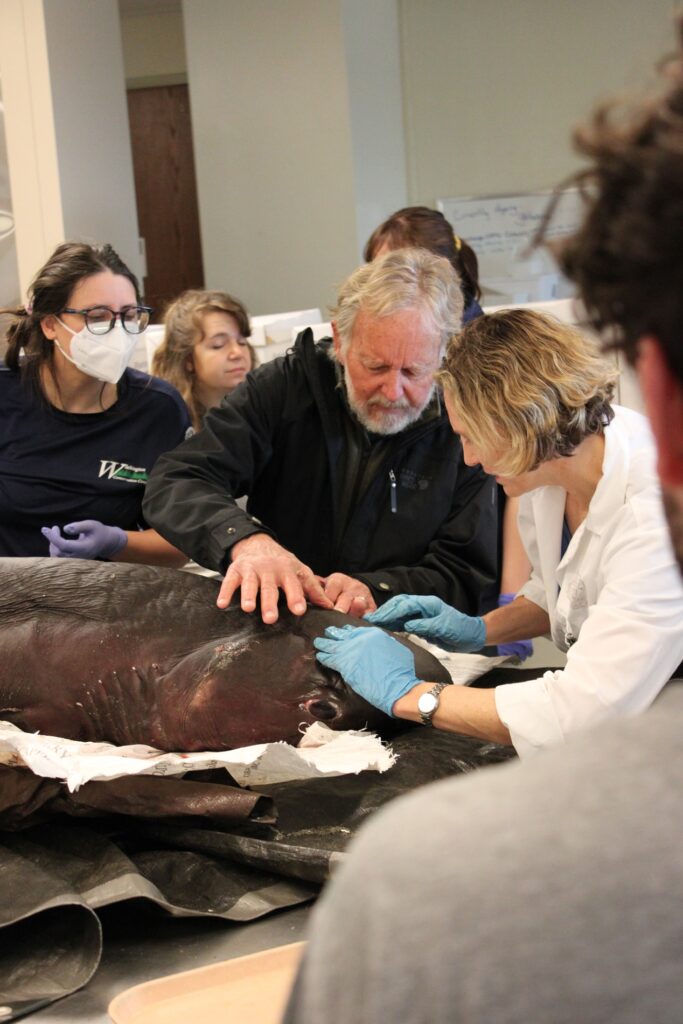
Reenacting the death
A likely scenario began to take shape. Fishers seeking bottom fish or salmon mistakenly caught this shark and, instead of cutting the line and releasing her, they may have reeled her in to retrieve the hook. The trauma of reeling her in and gaffing her head are the most likely causes of death. Fighting a hook and being dragged can cause exhaustion and asphyxiation, being reeled up from depth can cause trauma to organs, and being lifted with a gaff hook caused significant head injury.
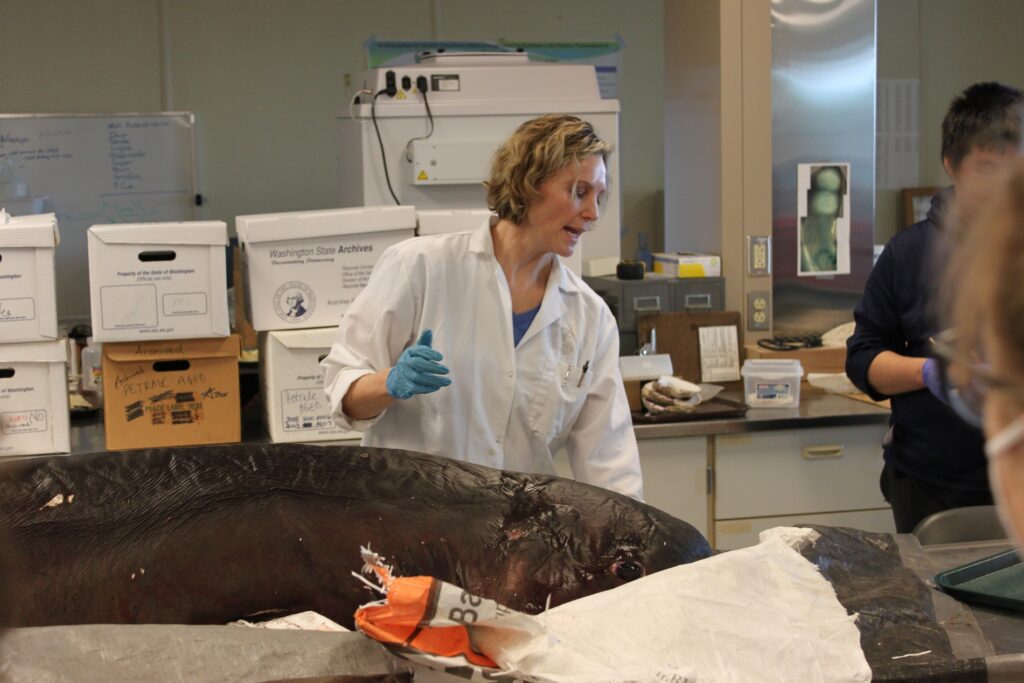
“People should know that fishing for sixgill sharks in Puget Sound is illegal and that even if the sixgill shark is an incidental catch, it is not okay to lift them from the water,” Hillier explained. “This girl was a big loss.”
“The best advice for fishers is don’t exhaust the animal by fighting it,” John Rupp adds. “Reel it in as easily as possible and then cut the line. Don’t try to remove the hook. Don’t gaff. Release the shark unharmed.”
Other than the trauma she suffered from being reeled in, the necropsy revealed that this shark was a robust, healthy female. Judging from her size, John Rupp hypothesized that she was about 10 years old, the age at which she would be ready to leave Puget Sound for the next phase of her life in the ocean. Now she will not be able to make that trip or return to Puget Sound to pass her genes to the next generation.
The necropsy was so meticulous and time-consuming, that the shark found at Sandy Shores had to be saved for another day. We still have not solved the mystery of why so many sharks have washed up this year. Are the deaths connected, do they have the same cause, or are they isolated occurrences that happened around the same time?
Regardless of the answers, we learned that even with a fishing ban on sixgills, Puget Sound still contains many dangers for our largest species of shark from swallowing derelict fishing gear and crab bait traps to incidental catch. Climate change may also pose a challenge. Scientists hypothesize that heating waters could stress mothers when they migrate to the shallows to birth and may result in less food available for pups.
Making a difference
What can we do to help this shark nursery of Puget Sound be a safe and healthy place for these creatures? Continue to report stranded sharks so that we can learn and find solutions, clean up derelict fishing gear, learn proper release tactics when sharks are accidentally caught, and support policies and personal actions that address global warming.
Aquatic Reserves Program Manager Roberta Davenport adds, “The State Aquatic Reserves program highly values engagement and reports from local community members. This enables agencies to respond, learn, and return information to the public.”
In the media and in science, we see devastating things happening to wildlife, ecosystems, and other humans daily. It can be very demoralizing. It was depressing to see several dead sharks within a short period of time. However, even though humans can disagree on a lot of things, I found an encouraging common thread through this experience — most of us care deeply about nature when we witness its devastation. The boy gently stroking the head of the shark on the beach, the Truman High students who are researching and writing a newspaper article about the shark they found, the volunteers who took the time to report and transport these sharks, the agency staff that received them — all of us want to live in a world where people are connected to each other, and to the lands, waters, and wildlife where we live. When we take time for caring actions, we create that community, and we bring a more nurturing world into being.
Report marine life in need of care or stranded marine life:
- Vashon Marine Mammal Stranding Hotline: marine-mammals@worldvets.org, 253-777-1775
- Local contact for questions on marine mammals: Orca Annie, 206-463-9041
- Stranded sharks and fish: WDFW fish program, 360-902-2200
- Poaching or illegal activity: 877-933-9847 or reportpoaching@dfw.wa.gov for non-emergencies; for in-progress, call 911 or sheriff.
- Problems or questions about wildlife in Maury Island State Aquatic Reserve: Roberta.davenport@dnr.wa.gov

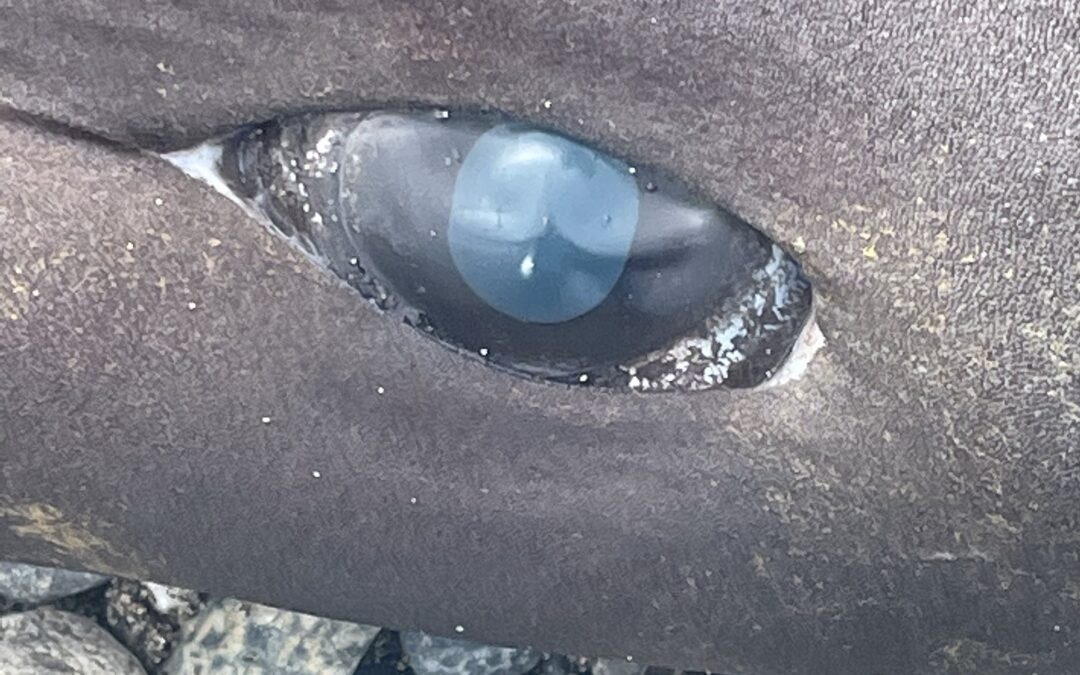
I don’t believe John Rupp knows much about fishing – certainly his comments as quoted don’t provide any confirmation of personal knowledge about commercial fishing: “Upon examination, Rupp immediately found a hook in the corner of the shark’s jaw. He explained that this was not the size of hook used for shark fishing (which is illegal for sixgills in Puget Sound), but one used for bottom trawling for fish like rockfish or salmon.” Trawling actually uses NETS not hooks. Trolling uses hooks, but rarely catches bottom fish as they target salmon in the upper 50-75 feet (typically) and are trolled behind the boat at speed and not set statically on the bottom. Groundfish fishing also uses hooks on set gear – but usually quite larger hooks than those shown in the pic provided. Looks like someone rec fished a shark and likely had too light gear to bring it in and the line parted – or cut the line once they saw it was a large shark.
Thanks for the input Dave! I think we made a typo in writing down the quote.
Elliot Bay ..27.5 foot long. Six gill, is the actual largest on record.! AND. 15 different species of sharks in the puget sound, which includes the GREAT WHITE..I Think the leopard shark is cute. Six gill is only aggressive if they think you are challenging them for their food .